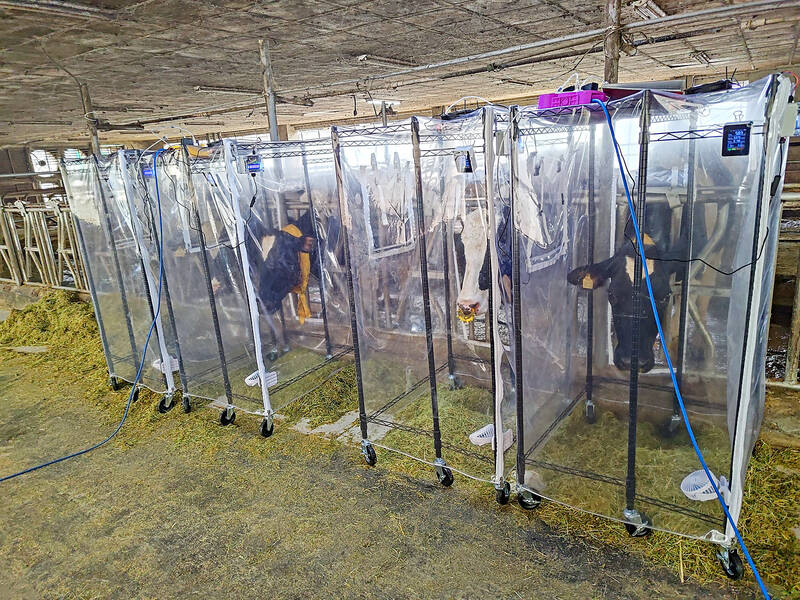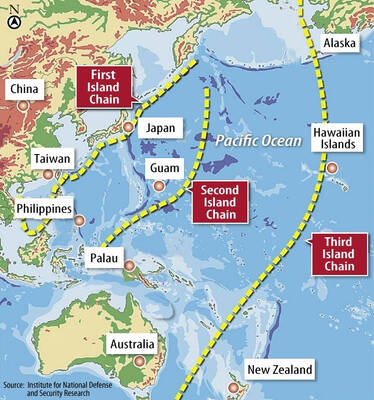Adjusting feed formulas can reduce dairy cows’ greenhouse gas emissions without affecting the amount of milk produced, the Taiwan Livestock Research Institute said on Thursday last week.
The annual carbon dioxide equivalent produced by lactating dairy cows feeding on a new formula was 4.5 percent lower, falling from 6,259kg to 5,975kg, it said.
The reduction was calculated using methods specified by the Intergovernmental Panel on Climate Change in 2006, it said.

Photo courtesy of the institute via CNA
The institute adjusted the ratio of corn and soybean oil meal in the feed — without changing the proportions of herbage, agricultural processing by-products and the concentration of the general feed — and gradually reduced the protein content of the feed from 18 percent to 15 percent, the institute said.
Reducing protein intake decreases the discharge of undigested nitrogen and cuts the production of nitrous oxide — also a greenhouse gas — as the cattle dung is fermented into compost, it said.
The change also lowered cows’ blood urea nitrogen levels and improved their health, it added.
Using agricultural by-products in cattle feed, such as brewer’s grains, pineapple skins and lemon peels, allows agricultural waste to be circulated and reused, it said.
In vitro experiments showed that the amount of methane produced by the cows’ rumens decreased when the proportion of the agricultural by-products was raised, it said.
The rumen is one of the cow’s stomachs. It produces methane — the second-most important greenhouse gas contributor to climate change — in the process of feed fermentation.
Earlier this year, the Ministry of Economic Affairs revised the national standard of formula feeds for livestock and poultry with the goal of reducing carbon emissions in livestock farming.
By adding maximum and minimum amounts of crude protein used in chicken and pig feed, the new standards were found to effectively reduce annual carbon emissions for each chicken and pig by 0.025kg and 7.24kg respectively, without affecting their growth, the institute said.

WANG RELEASED: A police investigation showed that an organized crime group allegedly taught their clients how to pretend to be sick during medical exams Actor Darren Wang (王大陸) and 11 others were released on bail yesterday, after being questioned for allegedly dodging compulsory military service or forging documents to help others avoid serving. Wang, 33, was catapulted into stardom for his role in the coming-of-age film Our Times (我的少女時代). Lately, he has been focusing on developing his entertainment career in China. The New Taipei District Prosecutors’ Office last month began investigating an organized crime group that is allegedly helping men dodge compulsory military service using falsified documents. Police in New Taipei City Yonghe Precinct at the end of last month arrested the main suspect,

A cat named Mikan (蜜柑) has brought in revenue of more than NT$10 million (US$305,390) for the Kaohsiung MRT last year. Mikan, born on April 4, 2020, was a stray cat before being adopted by personnel of Kaohsiung MRT’s Ciaotou Sugar Refinery Station. Mikan was named after a Japanese term for mandarin orange due to his color and because he looks like an orange when curled up. He was named “station master” of Ciaotou Sugar Refinery Station in September 2020, and has since become famous. With Kaohsiung MRT’s branding, along with the release of a set of cultural and creative products, station master Mikan

LITTORAL REGIMENTS: The US Marine Corps is transitioning to an ‘island hopping’ strategy to counterattack Beijing’s area denial strategy The US Marine Corps (USMC) has introduced new anti-drone systems to bolster air defense in the Pacific island chain amid growing Chinese military influence in the region, The Telegraph reported on Sunday. The new Marine Air Defense Integrated System (MADIS) Mk 1 is being developed to counter “the growing menace of unmanned aerial systems,” it cited the Marine Corps as saying. China has constructed a powerful defense mechanism in the Pacific Ocean west of the first island chain by deploying weapons such as rockets, submarines and anti-ship missiles — which is part of its anti-access/area denial (A2/AD) strategy against adversaries — the

Eleven people, including actor Darren Wang (王大陸), were taken into custody today for questioning regarding the evasion of compulsory military service and document forgery, the New Taipei District Prosecutors’ Office said. Eight of the people, including Wang, are suspected of evading military service, while three are suspected of forging medical documents to assist them, the report said. They are all being questioned by police and would later be transferred to the prosecutors’ office for further investigation. Three men surnamed Lee (李), Chang (張) and Lin (林) are suspected of improperly assisting conscripts in changing their military classification from “stand-by